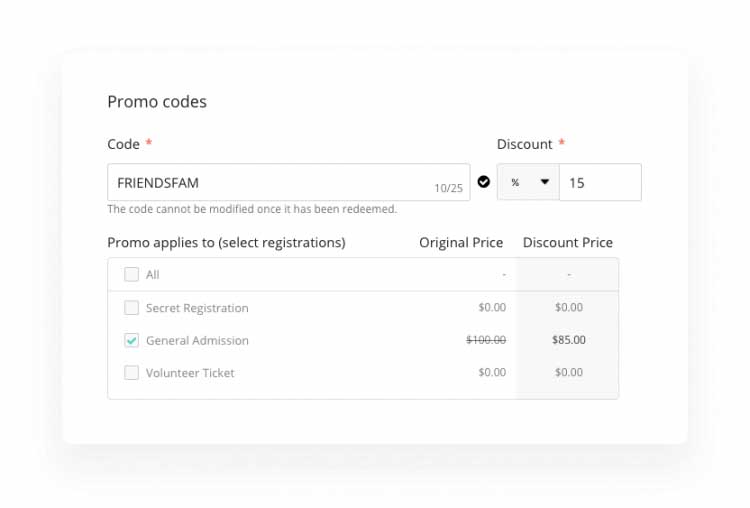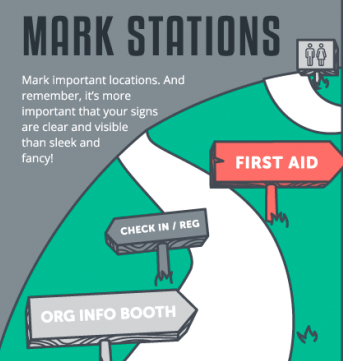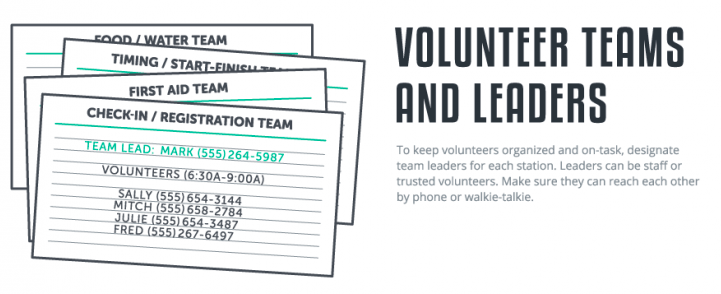How to Plan a 5K Run for Community Charity

When you know how to plan a well-organized 5K, your nonprofit organization has the potential to attract a cult following of avid racers and supporters who participate in your fundraising event or charity race series year after year. In fact, as a competitive runner for the last 10 years or so, I always make a hotel reservation for my favorite race for the following year on the same day that I run it.
The key to building such loyalty is to execute a charity event that not only runs smoothly, but also wows everyone involved. This includes people beyond just your runners. It’s also essential to create positive experiences for and develop relationships with your volunteers, local businesses, government officials, and the community at large.
Use these 24 tips on how to plan a 5K run for community charity to ensure that your nonprofit organization puts on a memorable event that crushes goals and that people look forward to participating in.
Check out this Beginners Guide to planning a charity run event before starting your planning process.
Free Download: How to Grow Your Run/Walk Event
1. Make it Easy to Sign Up and Receive Information
Classy’s State of Modern Philanthropy report show that traffic from mobile devices make up nearly half of traffic to all campaign types, so a seamless, mobile responsive online registration experience is a must. In addition to event registration capabilities, your site should also provide ample information for local runners and those from out of town. They should know things like:
- Where they can stay
- The best restaurants for carbo-loading the night before
- How to get to the pick-up buses (if available)
- Where to get dropped off
- Where they can park
- Which roads are going to be closed
Pro Tip: Make sure your online fundraising software makes it easy for participants to share their registration so that they can easily tap their networks for donations. Look into this 10-week social media plan before your next fundraising event.
2. Reward Runners Who Sign Up Early
Consider offering discount codes or a tiered pricing structure that increases as you approach the event day. This can benefit both your organization and the consumer. Runners who are loyal to your event or are early adopters are rewarded with a cheaper registration fee, and your organization has the opportunity to raise prices for the same offerings as the charity event nears.
An added bonus of using discount codes on Classy is that you can assign unique codes to specific event marketing tactics. For example, if you provide a friend and family discount to volunteers, current donors, and attendees from previous years, you can track the effectiveness of that effort once you perform your campaign retrospective.

3. Don’t Skimp on Water Access
This might seem like an obvious rule, but I’ve had to pay for post-race water before. When you have runners of all experience levels streaming through the finish line-99 percent of whom likely don’t have their wallets on them-and you fail to offer free water right away, you’re going to have some angry, and thirsty, runners.
Offer plenty of water bottles or cups at a race’s end as well as at regular intervals throughout the race. Here are a few additional tips for water station setup:
- Include the first station at mile two
- Set stations every two miles thereafter
- Use multiple tables on both sides of the road so all runners have optimal access
- Train volunteers on how to hold cups (two fingers holding the top of the rim, or flat on their palm for easy access)
- If you provide both water and an alternative, such as a sports drink or ice, place them on two separate tables and clearly label each with a sign
4. Provide Amenities After the Race
Delight participants by providing some type of food or refreshment (in addition to water) post-race. Consider working with sponsors to have items donated in exchange for brand exposure. Here are some examples of things you could provide:
- Juice, chocolate milk, coconut water, beer
- Orange segments
- Popsicles
- Simple sandwiches-bread, meat, cheese
- Bananas
- Granola/protein bars
- Chips or crackers
5. Design a Strategic Course
Your race course‘s design will directly impact a participant’s overall experience. When possible, avoid down-and-back routes and hairpin turns. These routes and turns often force runners to change directions by 180 degrees suddenly, which causes congestion and the runner to lose momentum. This is especially important to consider in short races like 5Ks where your fast athletes will lap slower competitors and cause congestion in the race path.
Be sure to share the race course map and key pieces of information, such as elevation changes, on your website in order to prepare runners. Also, notify runners ahead of time of any course obstacles that may impact race time. For example, let them know if a public transportation system will be crossing the race’s path, or if cars must occasionally be let through. If a competitive runner is unaware and forced to stop and dock time off of their race, it could be very frustrating. When possible, avoid routes with these obstacles as competitive runners may decide not to participate because of it.
6. Mark the Course Path

At no point in time during the race should a runner have to question their direction. A wrong turn could be highly upsetting to event participants and negatively impact their race time and overall experience. In order to create a positive race flow, clearly mark any turns that may cause confusion and consider posting a volunteer to direct runners.
7. Consider Your Target Running Audience
One of the beautiful things about running is that it encourages a wide range of athleticism. Running events have the potential to attract people of all fitness levels to participate, whether they’re couch-to-5Kers, walkers, PR chasers, or record breakers.
If you are wanting to grow your run or walk for charity, advertise your 5k to all levels of participation. You can also arrange a longer distance run after the 5K in order to attract competitive long-distance runners as well.
How much time roads can be closed for will depend on your arrangements with city officials. This will impact how long the course can remain open, and the level of competitiveness of your race. The less time you have the roads closed off, the more competitive your participants will need to be. If you decide to arrange a race that targets several audiences of runners, your race should empower the couch-to-5K runner to feel just as personally successful as the record breaker. For this to be possible, make sure you allow them the necessary time to finish.
8. Think Through Your Receiving Line
If you plan to distribute any key items after the race, such as pins or medals, place volunteers at the finish line to distribute these items. This ensures every participant receives the item without having to wait in a long line after the event. Offering race memorabilia is a great way to remain top of mind with a runner after the charity run.
Your reception area should also include water stations, a bag drop (for longer races), and a family meetup area (for larger races). Volunteers and heavy signage are critical for a successful and streamlined receiving process. Use large signs that display bib number ranges for the bag drop area, and letters of the alphabet for family meetup areas.
9. Offer Swag
Swag is now a must-have part of the race experience. Whether you offer branded pint glasses, T-shirts, race jackets, draw-string bags, or medals, you’ll want to think through what your demographic of participants would appreciate the most.
10. Use Starting Corrals or Waves
Usually denoted by color or letter, running corrals help to make a positive race-start experience by grouping runners of similar pace together at the start. This prevents race congestion and grants runners a less obstructive course.
Many races ask for verification of pace times in order to enter certain corrals. Depending on how large your charity race is, you may want to restrict access to each corral by setting up physical perimeters monitored by volunteers. When you restrict access, you ensure only runners qualified to run at that pace are in that designated starting group. This will prevent misrepresentation and contribute to a positive, uncongested course flow.
11. Display Mile Markers
While some runners may use GPS on their phones or watches to track their mileage, clear signage and mile marker clocks displaying the start/finish line time are great morale boosters for runners. For example, as runners cross mile two, they might see that it’s been 20 minutes and 30 seconds since the start gun fired. Depending on when they themselves crossed the start line, (and thus activated their own time chip), they can mentally adjust their personal time to this overall race time. If a runner noticed that they personally crossed the start line at 1:07, they would know that it’s taken them roughly 18:53 to get to the second mile marker. This helps orient them and informs them to be as successful as possible.
12. Kick Race Bibs Up a Notch
My favorite running events went out of their way to make participants feel special and part of a larger community. For example, I was recently offered the opportunity to select the text on my race bib, and I loved the personal touch. Many runners like to save their bib numbers as memorabilia and display them in some fashion, so offering this level of personalization can increase affinity for your bib numbers and make participants all the more likely to save and display them. This, in turn, reminds them of their experience and keeps your organization top of mind.
13. Recruit and Train Volunteers

Volunteers are your organization’s top secret weapon at a run/walk event so it is important to know the right way to onboard and train volunteers. Their level of training is the difference between a haphazard disaster and a well-oiled machine. Make sure to designate volunteers to the following tasks or locations:
- Race expo packet distribution
- Starting corrals
- Refuel stations
- Finish line
- Bag drop area
- Medical tent
- Post-race food/water/goodies distribution
- Bus transportation (if needed to or from the start or finish line)
- Cleanup
14. Engage the Local Community
Some of my most positive race experiences were the courses with high community engagement. Make sure your local community knows about your race and share ideas for how they can support your runners. Whether you ask people to bring cowbells and motivational signs or spray runners with a garden hose, get people involved. I’ve even entered races that featured local DJs and bands along the sidelines which created a strong sense of excitement. The more alive and community-powered your event feels, the more fun your runners will have and the likelier they’ll be to sign up for next year’s race.
15. Host a Killer Expo
Expos are a great way to involve corporations and local businesses at your event. I look forward to trying new products and shopping for any last–minute items I may need for the race. Consider which organizations you could recruit to participate in your expo in order to deliver a valuable experience for your race participants.
Free Download: The 10-Week Social Media Event Promotion Plan
16. Partner With Local Hotels
If you host an annual 5K or run/walk event, your organization is in a position to attract recurring business for local hotels. Designating an official “race hotel” is a great way to accommodate out of town participants and offer perks that delight your runners. Possible perks include packets of information at the front desk, a special runners’ breakfast, and event shuttles.
17. Don’t Skimp on the Portable Toilets
Runners will resort to extreme measures if we have to, but please don’t make us. Provide ample opportunity for your event participants to use a restroom before, during, and after your event. When planning for portable toilet rentals, consider key factors like the percentage of women attending your event (to avoid notorious long lines) and whether or not you serve alcohol.
18. “Wow” Runners at Your Refuel Stations
Entertaining races have a lot in common, but there are certainly subtle ways you can delight your participants and take your event to the next level. I distinctly remember times when I was pleasantly surprised by different and creative offerings at refuel stations. My favorites include volunteers holding out Vaseline, popsicles, ice cubes, and energy gel shots. I’ve also run races that set up sprinklers for runners to run through.
How to Grow Your Run/Walk Event
19. Get Certified
If you’re planning to organize a marathon, USA Track and Field certification affords your race participants the ability to use your race to qualify for the Boston Marathon. This will open your event up to competitive runners who may not consider your race otherwise.
20. Plan for Worst Case Scenarios
Whether it’s rain, thunder and lightning, or a medical emergency, your event staff needs to be prepared to deal with anything. Develop a plan B for as many hypotheticals as possible and consider if event insurance is a smart investment for your organization. To mitigate risk to your event participants, keep them informed about the weather and what they can do to prepare.
For longer races, you should also have medics onsite on the actual course on cycles to ensure a quick response to any medical emergency. A medical tent with EMTs and an ambulance at the post-race area is also a must for longer distances.
21. Offer Pace Runners
Pace runners agree to complete each mile of your event at a designated pace. This pace is typically denoted by the projected end time. For example, runners aiming to complete a half-marathon in two hours would keep an eye on the pacer holding/running with a 2:00 sign. These are generally very experienced runners who can maintain a set pace throughout the entire race to help keep other runners on track. One idea is to contact local shoe stores and ask their employees to run as pacers in exchange for their company’s brand exposure.
22. Power Your Race With Dynamic, Results-Driven Software
Race technology has advanced significantly in the last decade. From event registration software for nonprofits that can allow your registrants to raise money on behalf of your organization or participate virtually, to timing software that provides runners’ family members with split–time text alerts, investments in top-notch technology will ensure your race is an event that runners won’t forget.
Free Download: Anatomy of a Registration with Fundraising Campaign
23. Ask Runners to Come Back
Don’t let your race participants forget about their positive experience. It’s important to follow up with runners to thank them for their participation. By keeping them in the loop with your email communications, you can help them get excited for next year right away. I typically purchase race registration as soon as a race goes on sale, and if it’s an event I run every year, I have a calendar reminder set to ensure I don’t miss purchasing before prices increase. Be sure to hype your past participants up for the sale of next year’s tickets by keeping them informed of important dates and consider offering them a presale discount as a way to thank them for their previous support.
24. Help Runners Prepare With a 5K Training Plan
In order to create a positive experience for your participants, it’s important to provide them with tools that will set them up for success. This extra support will encourage them to recommend the event to others and participate year after year.
To save you some of this heavy lifting as you plan a fun run for charity, we’ve created a 9-week plan to organizing charity runs. Your organization can distribute it to event registrants so that they can prep leading up to the big day. All you have to do is download and add your logo. That way, it’s branded to your organization, and your nonprofit will remain top of mind after your registrants tape it to their bathroom mirror.
The following plan was developed from over 12 years of personal running experience. Each day has a beginner-level workout, as well as a workout for intermediate runners and a helpful list of tips for running success.
Free Download: Your Customizable 5K Training Plan
Get Started with Your 5K
The 5K run/walk is one of the most popular types of fundraising events for nonprofit organizations. But the financial return isn’t the only thing that makes it so effective. It’s powerful because of the way it also joins like-minded people together.
When you take measures to organize an event that truly exceeds your participants’ expectations, you generate positive word of mouth for your organization that boosts event loyalty and profitability. But beyond planning the ins and outs for the day of, it’s equally important to market your event in the time leading up to it in a way that will increase participation. Get more information on how to make your next 5K event a fundraising machine in the guide below.
Free Download: A Beginner’s Guide to Planning A Run/Walk

A Beginner's Guide to Planning a Run/Walk



